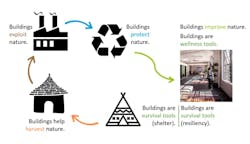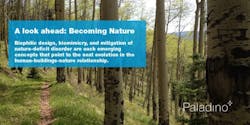Becoming nature: The building design evolution meets the living building revolution
There has been an observable series of changes throughout the history of the built environment. The changes moved slowly at first and now are exploding with innovative concepts. And all this change has been in the context of the powerful relationship between humans and nature.
And now the rapidly changing approach to the built environment is stumbling over rating systems on its way to provide a more harmonious connection between people, their buildings, and the environment.
Look back to look ahead: Coping with nature
- Early humans: Buildings are survival tools
- Neolithic revolution: Buildings help us harvest nature
- Industrial revolution: Buildings lose their symbiotic relationship with nature and are used to exploit nature
- Post-Industrial revolution: Buildings minimize the impact on nature. The green building movement is born!
- Third Millenia: Buildings are survival tools. Buildings improve nature. Buildings are wellness tools.
With the environmental movement, sustainability became a marker of innovation in design for the built environment. No longer were the most successful projects defined exclusively by functionality, inspiration, and economy.
Along the way, rating systems emerged as the rational method to back-check the safety and sustainability of the built environment. Building codes and local regulations combine with rating systems to establish and enforce a standard that can be trusted. LEED was one of the first and most influential market transformations, and now LEED is joined by a fragmented field of rating systems including WELL, LBC, ENERGY STAR, Salmon Safe, RELi, and many more.
This fragmentation of rating systems and performance standards forces architects, designers, and developers to make tough decisions about priorities. What is more important: the environment? Human performance? Climate resilience and recovery from natural disasters?
A look ahead: Becoming Nature
Building industry leaders are learning to integrate the key strategies behind the rating system and code requirements to realize more than a fragmented result – and to benefit people, profits, and the planet in one gesture.
Thanks to extraordinary building design that brings us closer to nature, architects can design buildings that enhance the natural environment and protect people from extreme climate events – all while improving human health, performance, and happiness. Biophilic design, biomimicry, and mitigation of nature-deficit disorder are each emerging concepts that point to the next evolution in the human-buildings-nature relationship.
A Paradigm Shift comes to rating systems
The change to an abundant human-buildings-nature relationship won’t happen overnight. And the market confusion around rating systems is a hurdle, rather than a helper. The data demonstrates that biophilic design and design for wellness improve the human experience, but there is a delayed reaction across the real estate industry. Here are four changes to the standard approach that can bring biophilic design to the forefront:
- Elevate the function of Place and Culture in the design process by analyzing ecosystem services and biophilic principles early development planning stages.
- Bring a broader set of scientific and social disciplines to the real estate development table.
- Synthesize the studies on wellness and the built environment so they can be understood and properly applied.
- Use rating systems as a back-check, and not a driver, of building design outcomes
Conclusion
Once we see the connections between nature and our human-built environment, we can embrace opportunities for design integration and achieve benefits that are not isolated to a single economic, health, environmental, or resiliency goal. By understanding how to integrate seemingly disparate sustainability goals (or hiring someone who does!), architects and developers can use extraordinary building design to achieve harmony between humans, nature, and our built environment. That’s Abundance!
About the Author
Paladino
Paladino and Company is a sustainability consulting firm that works with organizations seeking to make a difference through their buildings and people. Abundance, written by our team of architects, engineers, building scientists, commissioning agents and business analysts, reflects our rigorous business and building technical analysis centered on the concept of abundance as a driving force for change. Our consultants offer insights, expertise and vision on sustainability and how to realize its business value. For more, visit www.paladinoandco.com/blog. Follow on LinkedIn and Twitter.



